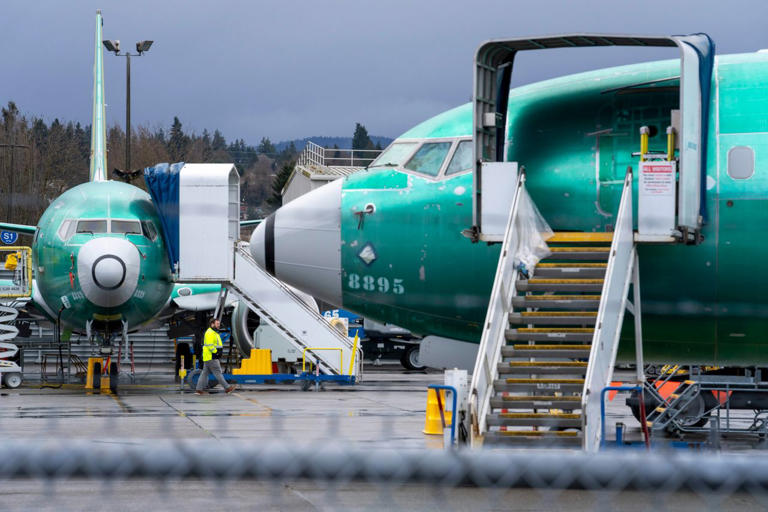Boeing is currently facing a multitude of challenges, including federal probes, quality issues in factories, dissatisfaction among airlines, strained union negotiations, and disruptions in the supply chain.
David Calhoun, who was brought in four years ago to address these issues, will be stepping down as CEO by the end of the year. His departure follows the ousting of his predecessor by the board, which Calhoun himself chaired.
Larry Kellner, Boeing’s Chairman and a key supporter of Calhoun, is also leaving his position, signaling a significant leadership shake-up within the company.
The impending leadership change has been met with approval from airline executives and government officials, who hope for improvements in Boeing’s operations and quality control measures.
Boeing’s board has initiated the search for a successor, considering both internal and external candidates. There is a pressing need to find someone capable of addressing the quality issues affecting the production of 737 MAX jets.
Comparisons have been drawn with General Electric (GE), where CEO Larry Culp has recently undertaken a five-year restructuring process. Culp’s insights suggest that Boeing faces a substantial amount of work ahead, similar to GE’s experience.
Boeing has set a timeline for Calhoun’s exit at the end of the year, allowing for a smooth transition period. However, a prolonged transition could potentially impede Boeing’s efforts to turnaround its operations.
The incoming CEO will encounter significant challenges, including the necessity for bold strategic decisions and the need to address internal and external concerns to restore confidence in the company.
Succession scramble
The recent shake-up at Boeing, announced on Monday following a close call involving a 737 MAX operated by Alaska Airlines on January 5th, shed light on deficiencies in the company’s succession plans. Despite Boeing’s board previously reaffirming their support for David Calhoun and extending his tenure beyond the typical retirement age of 65, concerns arose as Calhoun, who turns 67 next month, prepared for his departure.
Before the Alaska Airlines incident, Calhoun had designated Stephanie Pope, one of his key lieutenants, as his successor by promoting her to a prominent role within the company. However, as issues continued to mount, including the lack of an immediate successor for Stan Deal, the head of Boeing’s commercial unit, discussions among Calhoun, Larry Kellner, and other directors intensified regarding the necessity of expediting leadership changes.
Following the Alaska Airlines incident, which underscored the urgency for decisive action, Pope’s appointment to replace Deal as the commercial unit chief underscored the board’s recognition that delay was no longer feasible.
Simultaneously, several airline CEOs expressed their desire to directly address Boeing’s board to articulate their concerns and demand concrete plans for addressing the company’s quality problems. Boeing responded by offering meetings with Kellner and other board members, with Steve Mollenkopf now slated to lead these discussions as Boeing’s chairman and oversee the CEO search.
Mollenkopf, a former CEO of Qualcomm, brings a wealth of experience to Boeing. He successfully navigated Qualcomm through various challenges, including conflicts with activist investors, hostile takeover attempts, and legal disputes with major clients like Apple. While Mollenkopf is relatively new to Boeing, his background in Silicon Valley and on Wall Street positions him well to lead the company through its current challenges.
Struggles with Spirit
Calhoun had been actively addressing Boeing’s supply-chain issues by taking measures to address quality problems with fuselage maker Spirit AeroSystems. Boeing announced its decision to stop accepting flawed or problematic parts from Spirit this month.
The incident involving an Alaska Airlines door plug, which had to be reopened upon arrival at Boeing’s Renton, Washington factory, where workers then reinstalled it without necessary bolts, highlighted the severity of the quality issues. Subsequently, the plug blew off a plane at 16,000 feet a few months later, though fortunately, there were no fatalities.
Amidst these challenges, Calhoun has been engaged in negotiations with Spirit regarding a potential acquisition. However, reaching an agreement has been complicated, particularly as Spirit also supplies parts to Boeing’s competitor, Airbus.
Scott Kirby, United’s CEO, emphasized that addressing Boeing’s problems would be a lengthy process, spanning decades rather than mere months. Nonetheless, United expressed support for Boeing during its leadership transition.
The Federal Aviation Administration (FAA), Boeing’s primary regulator, has expressed concerns about the company’s operations since the Alaska Airlines incident. While Calhoun has shown willingness to implement changes requested by the FAA, the agency remains unsatisfied with the progress thus far.
Boeing’s recent quality-control issues, including those identified by the FAA during an audit of 737 production, have exacerbated tensions. Additionally, a seat mishap on a 787 Dreamliner flight prompted further scrutiny and safety concerns.
The Justice Department is reviewing a settlement with Boeing reached in 2021 after two fatal MAX crashes and has opened a criminal investigation into the Alaska Airlines accident. Union leaders representing Boeing workers are demanding representation on the board and commitments regarding future manufacturing locations.
Airline executives, frustrated by delivery delays and certification issues with Boeing jets, have faced operational challenges. Southwest Airlines announced schedule cuts due to delays, while United is considering Airbus jets as replacements.
As Calhoun’s tenure winds down, he may transition into a caretaker role, preparing for the arrival of a new CEO. However, the company’s strategic challenges remain significant, necessitating decisive action.
